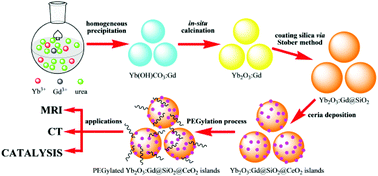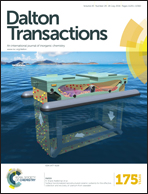Designed synthesis of multi-functional PEGylated Yb2O3:Gd@SiO2@CeO2 islands core@shell nanostructure†
Abstract
Nanomaterials that can restrain or reduce the production of excessive reactive oxygen species such as H2O2 to defend and treat against Alzheimer's disease (AD) have attracted much attention. In this paper, we adopt the strategy of layer-by-layer deposition; namely, first synthesizing available gadolinium-doped ytterbia nanoparticles (Yb2O3:Gd NPs) as cores, and then coating them with silica via the classical Stöber method to prevent leakage and act as a carrier for subsequent ceria deposition and PEGylation, and finally obtain the expected core@shell-structured nanocomposite of PEGylated Yb2O3:Gd@SiO2@CeO2 islands. The nanomaterial has proved not only to be a high-performance dual-modal contrast agent for use in MRI and CT, but also to exhibit excellent catalase mimetic activity, which may help the prognosis, diagnosis and treatment of AD in the future. In addition, scanning electron microscopy (SEM), transmission electron microscopy (TEM), energy dispersive spectroscopy (EDS), X-ray diffraction (XRD), X-ray photoelectron spectroscopy (XPS), and Fourier transform infrared (FTIR) spectroscopy characterization have revealed the successful design and synthesis of the cores with remarkable size uniformity, with well-distributed CeO2 islands decorated on the surface of SiO2 shells, and tightly immobilized PEG.


 Please wait while we load your content...
Please wait while we load your content...